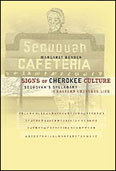 When tourists visit the casino town of Cherokee, North Carolina, they often underestimate the enduring elements of Cherokee culture behind the commercial façade.
When tourists visit the casino town of Cherokee, North Carolina, they often underestimate the enduring elements of Cherokee culture behind the commercial façade.
One of those elements is a Cherokee writing system.
Margaret Bender, assistant professor of anthropology at Wake Forest University, has spent almost three years looking at the Cherokee writing system and how it is used in special and subtle ways to help shape a shared cultural identity among the Cherokees.
 Bender’s new book, “Signs of Cherokee Culture: Sequoyah’s Syllabary in Eastern Cherokee Life,” is based on her extensive fieldwork in the western North Carolina community of the Eastern Band of Cherokee Indians. The book was published in June by the University of North Carolina Press.
Bender’s new book, “Signs of Cherokee Culture: Sequoyah’s Syllabary in Eastern Cherokee Life,” is based on her extensive fieldwork in the western North Carolina community of the Eastern Band of Cherokee Indians. The book was published in June by the University of North Carolina Press.
A native Cherokee invented the Cherokee writing system, or Sequoyan syllabary, in the 1820s. It quickly replaced alternative writing systems for Cherokee and was reportedly in widespread use by the mid-19th century. Most of the syllabary’s symbols represent a consonant-vowel combination that corresponds to spoken Cherokee language.
English is the predominant language used in the Cherokee community, but recent interest in cultural revitalization among the Cherokees has increased the use of the syllabary, says Bender, who teaches cultural and linguistic anthropology at Wake Forest.
“The things that most outsiders have contact with offer few windows into true Cherokee culture,” Bender says. “Although most Eastern Cherokees cannot read and write the syllabary in the conventional sense, the writing system plays an extremely meaningful role in contemporary Cherokee life.”
The Cherokee syllabary is still very much in use—in Cherokee language education, in churches, in Cherokee newspapers and other publications, she says.
Bender notes the prevalence of Sequoyah’s syllabary in elementary school classrooms in the community.
“A syllabary chart adorned the wall of nearly every classroom in Cherokee Elementary School. Colorful paper signs containing messages such as “hello” written in syllabary hung on many classroom doors,” she says. Many class assignments also involve use of the 85 traditional Cherokee symbols in one way or another.
The syllabary characters are also used in signs around the community to identify buildings as part of the Cherokee social and political structure, she says. Such buildings include a senior citizens’ center, day care center, clinic and the tribal council house. The use of the symbols indicates the spaces are local—meant for Cherokees rather than tourists, Bender says.
The use of the syllabary is also closely associated with Christianity. One of the key texts written in syllabary is the New Testament. So, many Sunday school teachers in the Cherokee community are proficient in using the writing system.
Syllabary characters also are used by the Cherokee to convey cultural pride and recognize achievements. In the book, Bender mentions T-shirts with syllabary characters that are given to Cherokee children when they complete a reading program or to children when they finish a drug prevention program.
Symbols from the syllabary are frequently used on items sold to tourists. For example, a character will be etched into the bottom of a piece of pottery to mark it as Cherokee. But, the symbols are used as a design, rather than for the purpose of representing actual words in Cherokee. The set of characters also often appears on mugs and other items produced for tourists.
In its commercial role, the syllabary generally functions as an icon of Cherokee history and authenticity, Bender says. But, outside the tourist arena, it becomes a more functional writing system that is used for religious and other purposes.
“The writing system is very useful for encoding the most important Cherokee cultural resources and knowledge.”
Categories: Arts & Culture, Faculty, Research, University Announcement
Headlines
Wake Forest in the News
Wake Forest regularly appears in media outlets around the world.




